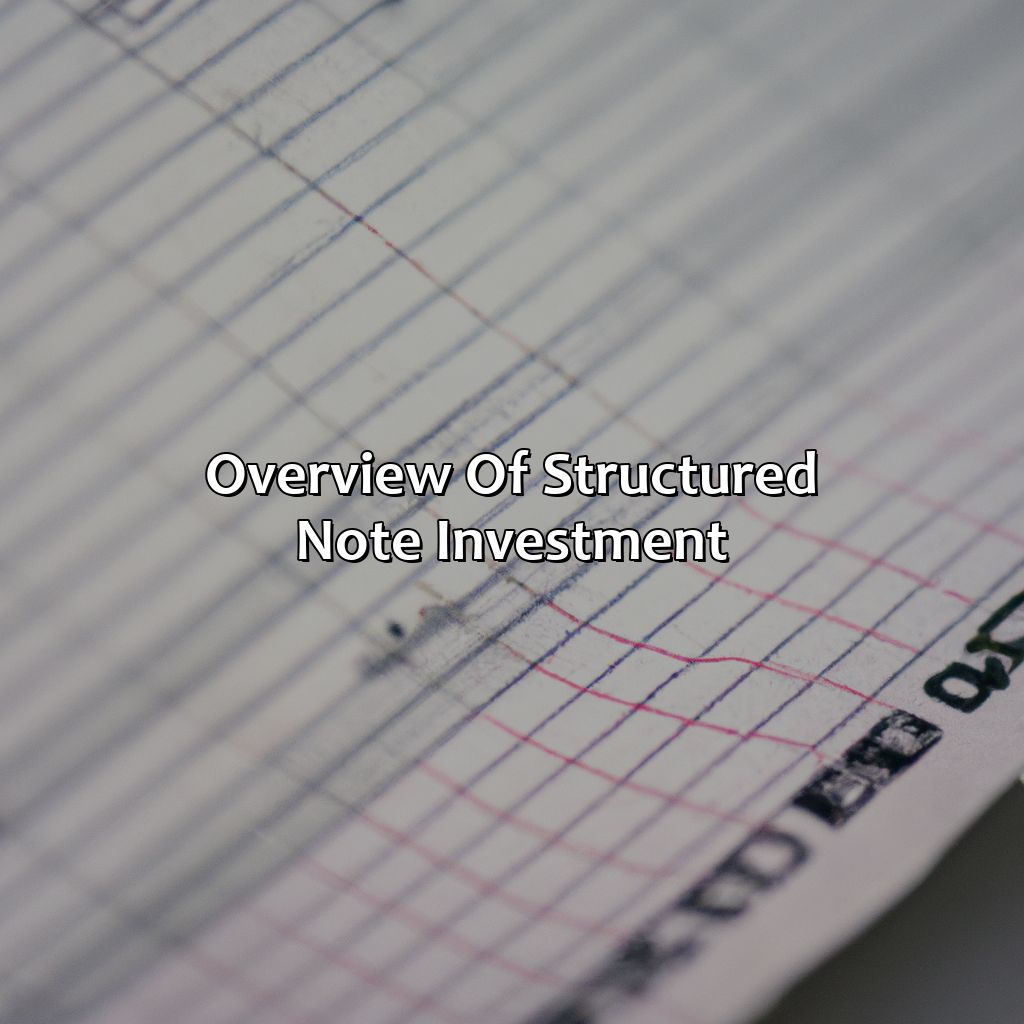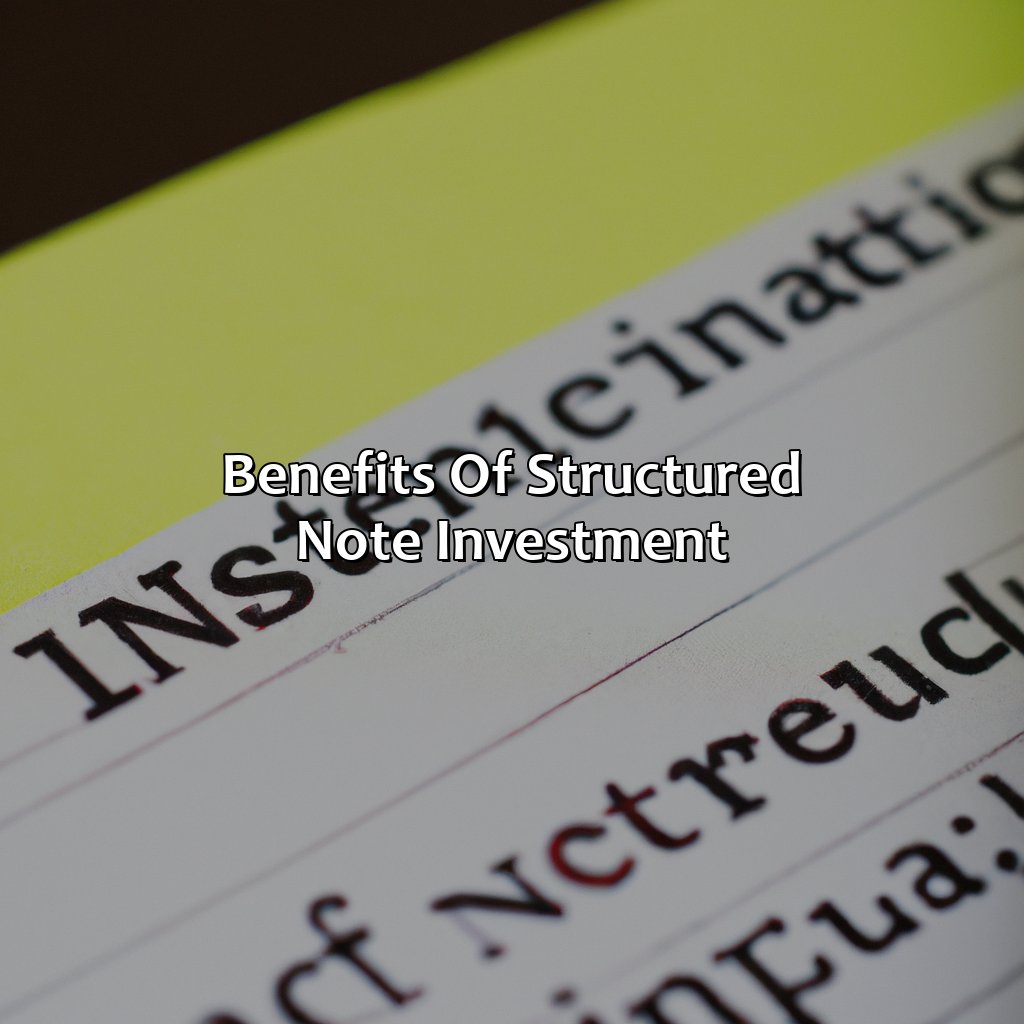What Is A Structured Note Investment?
Key Takeaway:
- Structured note investment is a type of investment that combines a traditional bond with derivatives, providing returns based on the performance of an underlying asset or index, while minimizing downside risks.
- Structured note investment offers customization options, allowing investors to tailor their investments to suit their specific investment needs and goals, such as hedging against interest rate or market risks.
- As with any investment, there are risks associated with structured note investment, including market risk, credit risk, and liquidity risk, so it is important to carefully consider your investment objectives, risk tolerance, and investment horizon before investing.
Are you considering investing in a structured note? Learn the basics of what these investments are and how they can benefit you. Find out the potential risks involved and how to make the right choice for your finances. You deserve to understand the advantages and disadvantages of a structured note investment.
Overview of Structured Note Investment
Gain a full understanding of structured note investments! Look at the overview of this investment using two frameworks: definition and features, and types. Explore these sub-sections to learn the unique traits and advantages. Also, discover the common types of structured note investment products in the market.

Image credits: retiregenz.com by Yuval Duncun
Definition and Features
Structured Note Investment – A Brief Insight
Structured note investment is a customizable financial product that combines a bond with a derivative, making it a highly versatile option for investors. These notes come with unique features such as variable interest rates, principal protection, various maturities and payout options.
These investments allow investors to leverage market opportunities while minimizing risks involved in traditional investments. Structured notes usually have lower transaction costs compared to similar hedge fund products that offer comparable returns.
Structured notes can be tailored to suit the needs of individual investors, like setting up barriers for how much an underlying security can move or indicating restrictions around default risk. Investors should research potential issuers and pay close attention to the fine print before making an investment decision.
To keep risks minimal and enjoy better returns from structured note investment, it is suggested to maintain diversification among assets and performing thorough due diligence on issuers and securities included in the underlying portfolio. Additionally, creating defined exits plans can help mitigate losses if unexpected events occur.
Looking for variety in structured note investment? There are more types to choose from than there are flavors at an ice cream shop.
Types of Structured Note Investment
Structured Note Investment Options
A structured note is an investment product that combines a bond with a derivative. Structured note investment options vary based on the underlying asset, level of risk, and complexity.
Types of Structured Note Investment
The table outlines some common types of structured note investments, including equity-linked notes, commodity-linked notes, currency-linked notes, and interest rate-linked notes.
| Type of Structured Note | Underlying Asset | Level of Risk | Complexity |
|---|---|---|---|
| Equity-linked notes | Stocks | High | High |
| Commodity-linked notes | Commodities | Medium | Medium |
| Currency-linked notes | Foreign exchange rates | Low to Medium | Low to Medium |
| Interest rate-linked notes | Interest rates | Low to High | Low to High |
When considering a structured note investment option, it’s essential to know the level of complexity and risk involved. Structured equity and commodity-linked investments are usually complex with high levels of risks compared to interest or currency-based options.
Structured Note Investment History
The first structured note was sold by Merrill Lynch in 1984. Since then, the market for these investments has grown significantly due to customization opportunities for investors and issuers and low-interest rates in the global economy.
Structured note investments: the only way to turn your financial portfolio into a real-life choose your own adventure book.
Benefits of Structured Note Investment
Understand the difference between structured note investments and traditional investments to reap the advantages. To get around the complexities of the financial market, explore the choices structured notes provide. Benefits include returns, risk management, customization and diversification.

Image credits: retiregenz.com by Adam Woodhock
Returns and Risk Management
Investing in structured notes can provide benefits in terms of generating returns while managing risks effectively. These notes are designed to cater to the specific investment goals and risk appetite of investors, ensuring suitability. By analyzing market conditions and investing in financial instruments that match these conditions, structured notes offer a higher potential for returns compared to conventional fixed-income investments.
Additionally, structured note investments usually come with varying levels of protection by capitalizing on derivatives contracts. This can ensure that investors’ principal amount is not entirely lost, even under extreme market scenarios. This type of risk management strategy provides enhanced financial security for investors.
It’s interesting to note that each structured note investment varies in structure, risk profile, and return potential, depending on the underlying assets and contracts used. This gives investors an opportunity to diversify their high-risk portfolio while also providing them with a customizable approach when it comes to meeting their investment goals.
Structured notes have been beneficial for many investors. One such example is Jenny Smith, who invested in a structured note back in 2018 as part of her retirement plan. Despite market volatility during the first quarter of 2020 amidst COVID-19 uncertainty, her investment still generated positive returns due to downside protection built into the note’s contract terms.
Structured notes – the only investment vehicle where customization is not just a fancy buzzword, but a requirement for survival.
Customization
Enhanced Personalization
Investors can expect an enriched personalization experience with structured note investments. This term refers to the flexibility granted by the asset manager when designing and structuring the note according to the investor’s needs. In other words, investors have more control over their investment portfolio and can tailor it to fit their unique requirements.
Below is a general overview of how customization works in structured note investments:
| Customization Element | Description/Example |
|---|---|
| Underlying Asset | Investor chooses the underlying asset class (equity, commodity, etc.) |
| Bond Coupon Rate | Investor specifies a fixed or floating rate of interest for bonds. |
| Scheduled Payments | An investor decides when they will receive principal payments or coupons. |
Besides these three elements mentioned in the table above, other details such as maturity date, currency type, barrier level(s), knockout/protection rates are also customizable based on individual preferences.
It’s essential to understand that customization doesn’t eliminate or reduce risks but adjusts them while balancing expected returns. For example, if an investor no longer requires a particular feature within the pre-decided templates, they can approach their asset manager and choose additional features of their liking.
Interestingly enough, customizing structured notes isn’t a recent phenomenon; institutional investors often utilize alternative assets such as derivatives with specialized terms and customized counterparty credit risk exposure. Thus customization has always existed in varying forms throughout history.
Who needs a diversified portfolio when you can just invest all your money in beanie babies?
Diversification
Expanding on the advantages of investing in structured notes, one key benefit is the ability to enhance diversification by investing in different asset classes. This reduces overall portfolio risk and helps investors achieve their investment goals.
Investing in a variety of asset classes, such as equities, fixed income, currencies or commodities, can improve the portfolio’s risk/return profile. Structured notes enable investors access to a range of assets that might not be otherwise available for purchase due to limitations on investment capital or knowledge.
Structured notes can also provide exposure to strategies that are not typically available through traditional investments. By using a combination of assets and derivatives, structured notes can provide tailored solutions to the specific needs of an investor.
It is worth noting that while diversification can reduce portfolio risk, it does not guarantee against loss. It is important for investors to consider their own circumstances and financial objectives before investing in any product.
As an example of successful diversification through structured note investment: A high-net-worth investor with a $5 million equity-dominated portfolio invested $1 million into a principal protected note linked to a basket of emerging market stocks and currencies. The investor used this strategy to increase diversification globally while protecting principal investment capital. Over time, the note delivered strong returns whilst reducing downside risk during periods of market volatility.
Behind every structured note investment lies a potential risk, like the person next to you on a roller coaster who ate a burrito before getting on.
Risks of Structured Note Investment
Evaluate risks when considering structured notes! Market, credit, and liquidity risks are potential pitfalls. These can affect returns and payout structure. So understand the risks – read on!

Image credits: retiregenz.com by Harry Woodhock
Market Risk
Structured Note Investment is exposed to a multitude of dangers tied to market dynamics. The investment may seize profits due to decreased liquidity, botched underwriting or creditworthiness of the issuer.
The fluctuation in exchange rates and interest rates, changes in government policies, economic conditions, geopolitical instability can jeopardize the investor’s return on investment. Other risks could be non-transparency of the complex contracts and lack of regulatory supervision.
Investors who take calculated risks based on thorough understanding could possibly gain dual benefits of higher returns and diversification. Nevertheless having no capacity or expertise in comprehending the underlying assets that structure note invest into must be vigilant as it equatess the potential risk with rewards.
In early 2018, GBP 223m were lost to Lloyds Bank customers via structured note investments compared to as little revenue of GBP 7Gbp just a few months earlier. Lloyds acknowledged adequate governance systems and improved practices that minimized such exposures going forward.
Adding structured notes to your portfolio is like playing Russian Roulette with your credit score.
Credit Risk
Structured notes investments may expose investors to credit risk, which is the probability of a loss arising due to credit events such as default or credit rating downgrades by issuers. In such structured note arrangements, where an investor purchases a security product created by a financial institution, the investor depends on the issuer’s ability to satisfy its repayment obligations.
The credit ratings of the issuing banks or financial institutions are significant indicators of their creditworthiness and default risk. Thus, investing in structured notes with low-rated issuers may carry higher risks. Although some notes come with guarantees or collateralization that mitigate their underlying risks, they may not be fully protected against credit losses.
Investors should conduct thorough due diligence before purchasing structured notes and accessing information about the credit history of the issuer. They can also consider diversifying their portfolios across other asset classes and geographical regions to minimize concentration risk. Moreover, working with an experienced investment advisor can help investors assess the suitability of these investments based on their financial goals and risk appetites.
Structured notes: the financial equivalent of a Roomba on shag carpet – it might seem like a good idea, but when it gets stuck in a corner, you’re in for some serious trouble.
Liquidity Risk
Structured Note Investment Uncovers the Hidden Liquidity Menace
Investing in structured notes may contain a perilous liquidity hazard. It can be challenging to sell these notes at short notice and obtain their estimated value during normal market conditions or when the issuer experiences financial difficulties.
Marketable securities like traditional bonds, mutual funds, and stocks are readily exchangeable since they have a large market of buyers and sellers leading to high liquidity. However, structured notes may have an illiquid secondary market even though there could still be a primary regular source for selling them.
When managing the risk of investing in structured notes, investors must consider the level of liquidity according to individual circumstances. Nonetheless, structured note investments can offer higher returns than bonds or other conventional securities that possess similar characteristics.
In today’s unstable investment environment dominated by low bond yields and immense stock volatility, investing in structured notes might be beneficial. Still, potential investors must assess their appetite for risk and examine whether these products match their financial targets.
Before diving into structured notes, consider factors beyond just the potential returns – like the fact that playing Russian roulette with a fully-loaded pistol also has high risk/high reward potential.
Factors to Consider Before Investing in Structured Notes
It’s key to think about your investment goals, danger acceptance, and how long you plan to invest when considering structured notes. In this part, we’ll go through these issues in detail. We’ll also list the pros and cons of each option. That way, you can make a wise investment pick.

Image credits: retiregenz.com by James Duncun
Investment Objectives
Investment goals should be defined before investing in structured notes. Aligning these objectives with the investment’s potential risks and returns is crucial to obtain desired outcomes. The structured notes market offers various products catering to different investment objectives, including capital protection, income generation, and enhancing returns.
Investors seeking capital protection may choose principal-protected notes, whereas those seeking income can opt for interest or coupon-bearing notes or credit-linked notes. Structured notes offer flexibility in capturing market changes and responding to investors’ preferences by having customizable features. Nevertheless, one needs adequate knowledge of the underlying assets, creditworthiness considerations of note issuers, and associated risks.
Before investing in structured notes evaluating risk-return metrics, liquidity positions becomes quintessential to ascertain the suitability of investments aligning with individual goals. One should also consider tax implications and costs related while investing in structured notes.
Pro Tip: Thoroughly understand the note issuance process and consult experienced professionals before making investment decisions in complex structured products. Before investing in structured notes, consider your risk tolerance. Unless you enjoy living on the edge, maybe stick to the boring old savings account.
Risk Tolerance
Assessing Capacity for Risk
Before investing in structured notes, it is vital to evaluate an individual’s capacity for risk. One must consider specific factors related to their financial goals and the ability to tolerate losses. Understanding risk tolerance helps an investor in making informed decisions based on their objectives and preferences.
Based on an individual’s capacity for risk, they may choose a structured note that aligns with their financial goals. Furthermore, investors should always aim for a well-diversified investment portfolio that provides balance and minimizes potential risks and losses.
It is crucial to evaluate investment suitability more broadly than just considering the classification or potential performance of the structured notes. As market conditions evolve over time, so too can individual circumstances such as the objective behind investible assets and what level of loss they could afford.
To ensure that your investment portfolio supports your long-term financial security, consult with certified professionals who can provide insight into optimal investment strategies based on unique circumstances.
Investors seeking higher returns have relatively higher capacities for risks, whilst those seeking lower risks tend to prefer guaranteed options such as bonds. Always consult with professionals before making any vital investment decisions.
Before investing in structured notes, consider your investment horizon – or how long it takes for regret to set in.
Investment Horizon
A Consideration towards the Duration of Investment
Structured notes, with their high level of customization, can be an attractive investment option for those seeking a tailored strategy. However, it is crucial to understand that these investments often require a longer-term horizon than traditional securities like stocks and bonds. The investment horizon for structured notes could range from a few months to several years, depending on the nature of the note.
When considering investing in structured notes, it is essential to evaluate your individual financial goals and needs against the required duration of the investment. This includes understanding the potential market conditions during that time frame and assessing whether you are prepared to hold onto your investment throughout the term.
It’s pivotal that investors comprehensively assess their financial situation, consulting experts where needed before making any substantive investment moves. For instance, a client fervently wanted an equity-linked note (ELN) but had not considered how long she was willing to hold onto it or quantified how much profit she sought to gain from such an investment. After discussing her objectives explicitly with a wealth advisor, they helped her select an ELN that would provide enough exposure without vast downside risk while offering sufficient returns over two years – which comfortably met her requirements.
Five Facts About Structured Note Investments:
Structured note investments are complex financial products that combine a bond with a derivative component. (Source: Investopedia)
These investments are typically sold by banks to individual investors and come with a wide range of payoff structures. (Source: The Balance)
Structured note investments offer the potential for higher returns than traditional bonds, but also carry higher risks. (Source: Forbes)
They are often used by investors to gain exposure to specific markets, such as commodities or foreign currencies. (Source: Financial Times)
Structured note investments are not suitable for all investors and require careful consideration of their unique risks and potential benefits. (Source: FINRA)
FAQs about What Is A Structured Note Investment?
What is a structured note investment?
A structured note investment is a type of investment vehicle that combines a traditional bond with certain derivative components. The goal is to provide investors with a customizable and potentially higher-yielding investment opportunity.
What are the advantages of investing in structured notes?
Some of the advantages of investing in structured notes include the potential to earn higher returns, the ability to customize an investment to meet specific goals, protection against market volatility, and access to a diversified range of underlying assets.
What are the risks associated with investing in structured notes?
Like any investment, structured notes come with risks. Some of the risks associated with this type of investment include the potential for a loss of principal, the fact that returns are not guaranteed, the potential for illiquidity, and the complexity of the investment.
Who should consider investing in structured notes?
Investors who are looking for a potentially higher-yielding investment opportunity and who are comfortable with a certain level of risk may want to consider investing in structured notes. However, this type of investment may not be suitable for all investors, particularly those who are risk-averse or who do not have a thorough understanding of the investment’s complexities.
How are structured notes structured?
Structured notes are typically structured as a bond that pays a fixed or variable rate of interest over a predetermined period of time, with the potential for an additional return based on the performance of one or more underlying assets, such as stocks, indices, or commodities.
What is the typical term for a structured note?
The term for a structured note can vary, but it is typically between three and ten years. Some notes may have shorter or longer terms depending on the specific investment objectives and underlying assets.
 Checkout this IRS Loophole
Checkout this IRS Loophole 
